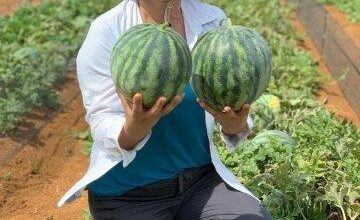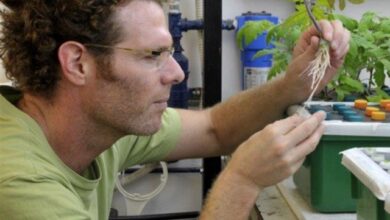Introducing the New PolySulphate Fertilizer
An in-depth article by ICL'sP Chief Agronomist Patricia Imas, about PolySulphate -a unique new multi-nutrient fertilizer, with four nutrients: sulphur, magnesium, potassium and calcium.
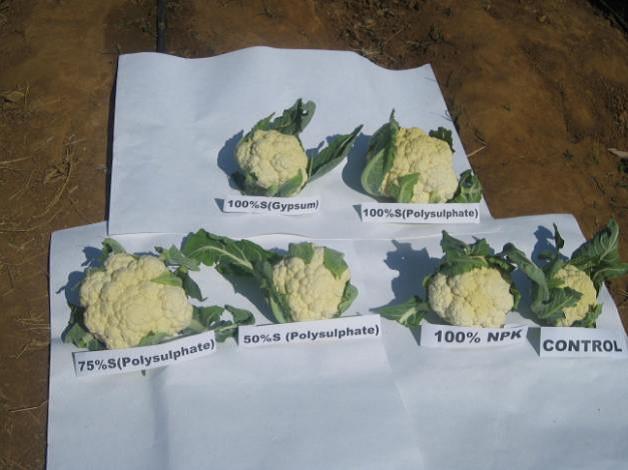
by Patricia Imas, Chief Agronomist, ICL Fertilizers, Patricia.Imas@icl-group.com
Introduction
PolySulphate is a new multi-nutrient fertilizer, available in its natural state, and mined in the UK. It has four nutrients, which makes it a unique product: sulphur, magnesium, potassium and calcium. It is a soluble material therefore its nutrients are readily available for plant uptake.
PolySulphate comes from the polyhalite layer of rock, over 1000m below the North Sea off the North Yorkshire coast in the UK. Deposited 260 million years ago, it lies 150-170 m below the potash seam at the Cleveland Potash Boulby Mine. The main PolySulphate seam was reached in September 2010, bringing the first samples up to the surface.
PolySulphate is a naturally occurring mineral fertilizer and is available as both a granular and powder product. It can be applied in many forms to the soil according to the consumer demand (straight fertilizer, or can be used in blends or for use in compound fertilizer manufacturing). The 2-4mm granular product has excellent spreading characteristics and is an ideal fertilizer to apply alongside straight nitrogen. It is suitable for all crops and being a low chloride fertilizer, it can be applied to even the sensitive ones.
PolySulphate is available in its natural state and has a low carbon footprint. It delivers dependable high value for low environmental impact and is certified for organic use.
PolySulphate contains:
- 48% SO3 as sulphate
- 14% K2O as from sulphate of potassium
- 6% MgO as from magnesium sulphate
- 17% CaO as from calcium sulphate
Benefits of sulphur, potassium, magnesium and calcium
PolySulphate is an ideal natural source for all crops, especially brassicas, cereals, pulses, field vegetables, clover-rich grassland leys and silage crops. It is particularly suitable for crops which prefer low levels of chloride in the soil, such as tobacco, grapes and other fruits, and where higher dry-matters are desired in potatoes.
Sulphur (S) is absorbed primarily in the sulfate form (SO4-2) by plants. It is part of every living cell and required for synthesis of certain amino acids (cysteine and methionine) and proteins. Sulphur is also important in photosynthesis and crop winter hardiness. Leguminous plants need S for efficient nitrogen fixation.
Crops such as corn that have a high dry matter production generally require the greatest amount of sulfur. Also potatoes, cotton, sunflower, canola (rape seed), Brassicas (cabbage, broccoli, cauliflower) and many other vegetables require large amounts of S.
When S is deficient, nitrate-nitrogen may accumulate. This can pose significant health threats to grazing ruminants or those consuming hay high in nitrates. When nitrates accumulate in the plant, seed formation can be inhibited in some crops such as canola. Balancing sulfur with nitrogen nutrition is important to both plant and animal health.
Over the last 20 years, S deposition from the atmosphere has declined significantly: the anthropogenic emissions of sulphur – usually as sulphur dioxide (SO2) from the burning of fossil fuels, particularly coal – had reduced to such an extent, and so widely, that the S content of PolySulphate became of great potential significance as a nutrient to counter S deficiency in crops and grassland.
In addition to sulphate, PolySulphate has the added bonus of valuable levels of potassium (K), magnesium (Mg) and calcium (Ca).
Potassium (K), along with nitrogen (N) and phosphorus (P), is one of the three essential plant macronutrients, and is taken up by crops from soils in relatively large amounts. Potassium increases yield and quality of agricultural produce, enhances the ability of plants to resist diseases, insect attacks, cold and drought stresses and other adverse conditions. It helps in the development of a strong and healthy root system and increases the efficiency of the uptake and use of N and other nutrients. In addition, K has an important role in livestock nutrition The K in PolySulphate complements routine fertilizer K applications.
Magnesium is an essential component of the chlorophyll molecule, with each molecule containing 6.7% Mg. Magnesium also acts as a phosphorus carrier in plants. It is necessary for cell division and protein formation. Phosphorus uptake could not occur without Mg and vice versa. Therefore Mg is essential for photosynthesis, phosphate metabolism, plant respiration and the activation of several enzyme systems. It is removed in significant quantities at harvest of all crops, and an application from PolySulphate provides a useful input of a nutrient that is frequently overlooked.
Calcium is the fourth constituent of PolySulphate, which means that it has effectively no non-nutrient constituents. Calcium is responsible for proper plant cell division and for strengthening cell walls. Calcium improves the absorption of other nutrients by roots and their translocation within the plant. It activates a number of plant growth-regulating enzyme systems, helps convert nitrate-nitrogen into forms needed for protein formation and contributes to improved disease resistance. PolySulphate helps to maintain essential calcium reserves in the soil. PolySulphate can play an important role as Ca source in tropical, acidic soils where Ca deficiency can be found and Ca supply can alleviate aluminum toxicity symptoms which are common in those regions.
Experiments with PolySulphate
Proprietary and independent trials have shown PolySulphate to be as good as the best sources available of the principal nutrients it contains. PolySulphate trials have focused on establishing that its nutrients – sulphate, potassium, magnesium and calcium – are readily available to the plant. Crop samples were grown in pots and given standard sources of pure potassium and magnesium sulphates, or PolySulphate.
Uptake of the PolySulphate nutrients by the plants was found to be as good if not better than the standard already used in the field. The results confirm PolySulphate’s effectiveness as a multi-nutrient fertilizer.
RELATIVE NUTRIENT UPTAKE FROM POLYSULPHATE COMPARED WITH EQUIVALENT STANDARD NUTRIENT SOURCES AND UNFERTILIZED CONTROL

These trials have been repeated many times over the last ten years, both in pots and in the field. In every case PolySulphate has performed equally well or better than the best standard alternatives.
Field trials in the UK have also investigated the response of cabbage to sulphate fertilizer. The results showed a 40% yield improvement from an application of PolySulphate.
WHITE CABBAGE YIELD RESPONSE TO POLYSULPHATE
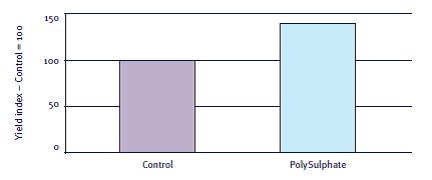
PolySulphate has been also tested in field trials for some major arable crops in France. In winter wheat, addition of PolySulphate to ammonium nitrate gave a 1.8 to 2.1 q/ha surplus (statistically significative) at different locations. In potatoes, PolySulphate increased the yield by 7.0 t/ha as compared with the agricultural practice which consisted in a complete fertilization including non-limiting levels of P, K and Mg. These field trials confirm the agronomic efficiency of PolySulphate.
In India, experiments done at the Indian Institute of Horticultural Research in Karnataka showed that application of PolySulphate resulted in significantly higher head diameter, head weight and head compactness of cabbage and cauliflower crops.
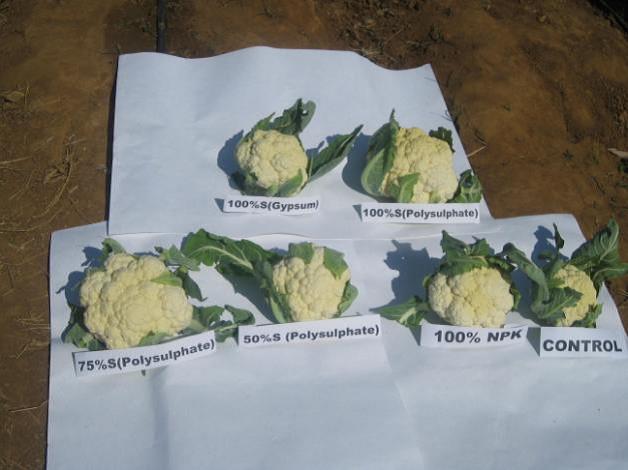
Another field experiment performed at CSAUA&T University in Kanpur, U.P. (India) showed that the yield of mustard increased significantly with the use of 50, 75 and 100% sulphur through PolySulphate. Maximum grain yield was recorded at the treatment with 100% S through Polyphosphate, and was found significantly better than gypsum. In this treatment, the yield increase was 52.7% as compared with the control treatment (only N and P application).
Spreadability trials have been undertaken with granular 2-4mm PolySulphate. The trials, carried out in Denmark and Germany, confirmed an excellent overlapped spread pattern at a 24-metre bout width, with a coefficient of variation of 4.3, and good spreadability up to 36 meters.
SPREADING STRAIGHT POLYSULPHATE

Getting the best from PolySulphate
PolySulphate has a number of key benefits, which makes it an ideal choice of sulphate fertilizer for farmers. It offers the chance to fulfil the potential of a range of crops.
PolySulphate is:
· Readily available – already in its soluble, sulphate form for rapid uptake
· Essentially a straight form of sulphur, offering flexibility to tailor application to field requirements
· Concentrated, so has a low storage requirement and is quick to spread
· A source of potassium, magnesium and calcium – an added bonus
· Low in chloride, so suitable for chloride-sensitive crops
· Environmentally benign as it used in its natural state – no processing or waste product, and non-acidifying
· UK-sourced and a secure supply of fertilizer with a low carbon footprint.
Advice for arable crops
PolySulphate can be applied in one dressing at the beginning of spring growth. The aim is to match the sulphur requirements to the crop’s nitrogen needs.
Where nitrogen rates are varied, in precision farming systems for example, the PolySulphate dressing can be independently varied to best match overall nitrogen applications.
Cereals and oilseeds
- Apply as a straight fertilizer at the start of spring growth
- Readily available, the crop will take it up with the nitrogen over the spring growing period
- Apply to oilseed rape to optimize yield, protein and oil synthesis.
- Apply to bread-making wheats for yield and to ensure grain protein quality
- Apply to malting barley for yield and quality
Peas
- Apply in the seedbed or soon after emergence
- A zero-N fertilizer, bringing readily available sulphur to the crop
- Used by the plant at an early stage to feed the nitrogen-fixation process, which occurs within the root nodules and for protein synthesis in the plant.
- Brassica field vegetables
- Brassica crops have been shown to be particularly responsive
- Apply as a base dressing, especially on high-risk light soils
Advice for livestock farmers
Applications of manure and slurry cannot be relied on as a source of available sulphate, and are best considered as maintaining soil reserves. So PolySulphate should be applied in line with nitrogen requirements as necessary to achieve optimum grass growth throughout the season at the correct N:S ratio.
Conserved leys:
- Apply after each cut of silage to complement nitrogen uptake and maintain N:S ratio.
- On lighter soils an application at the start of the spring may also be required.
Grazed leys:
- Apply after stock is moved on in rotational systems
- If set-stocked, and especially on lighter soils, apply early at the start of spring.
Clover leys:
- Provides an excellent sulphur boost for later-growing clover
- Apply as spring growth gets underway – earlier growing ryegrass will have taken up soil sulphur reserves.
PolySulphate production
PolySulphate is the trade mark of the mineral ‘Polyhalite’, which is one of a number of evaporate minerals containing potassium. The content of impurities is low, and is almost entirely sodium chloride at a maximum inclusion of 5%. Polyhalite (dehydrate) is a single crystal complex with 2 molecules of water of crystallization. It is not a mixture of salts. The chemical formula is:
K2Ca2Mg(SO4)4•2(H2O)
A seam of high grade polyhalite was found in the United Kingdom, below the existing sylvinite seam which is being mined for the production of KCl (potassium chloride or muriate of potash) by Cleveland Potash Ltd. Twin shafts were sunk into the polyhalite seam from the potash level in the existing mine and the mineral is being extracted. This is the first operational polyhalite mine in the world.
Unlike blended or compound fertilizer, PolySulphate is available in its natural state. It is mined, crushed, screened and bagged, involving no chemical separation or other industrial processes.
Available in its natural form, PolySulphate is UK-sourced and has a low carbon footprint. It delivers dependable high value, for low environmental impact. The natural process by which PolySulphate is produced makes it a low carbon footprint fertilizer. This helps growers achieve carbon targets demanded by retailers and some food processors.
For more details check Polysulphate website at http://www.polysulphate.com/



